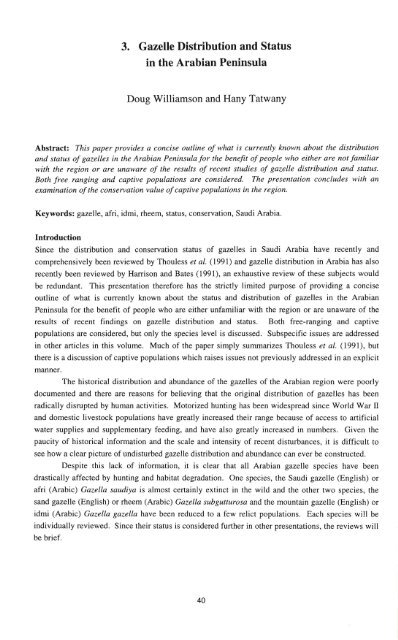CONSERVATION OF ARABIAN GAZELLES - Nwrc.gov.sa
CONSERVATION OF ARABIAN GAZELLES - Nwrc.gov.sa
CONSERVATION OF ARABIAN GAZELLES - Nwrc.gov.sa
Create successful ePaper yourself
Turn your PDF publications into a flip-book with our unique Google optimized e-Paper software.
3. Gazelle Distribution and Status <br />
in the Arabian Peninsula <br />
Doug Williamson and Hany Tatwany<br />
Abstract: This paper provides a concise outline of what is currently known about the distribution<br />
and status of gazelles in the Arabian Peninsula for the benefit of people who either are not familiar<br />
with the region or are unaware of the results of recent studies of gazelle distribution and status.<br />
Both free ranging and captive populations are considered. The presentation concludes with an<br />
examination ofthe conservation value ofcaptive populations in the region.<br />
Keywords: gazelle, afri, idmi, rheem, status, conservation, Saudi Arabia.<br />
Introduction<br />
Since the distribution and conservation status of gazelles in Saudi Arabia have recently and<br />
comprehensively been reviewed by Thouless et ai. (1991) and gazelle distribution in Arabia has also<br />
recently been reviewed by Harrison and Bates (1991), an exhaustive review of these subjects would<br />
be redundant. This presentation therefore has the strictly limited purpose of providing a concise<br />
outline of what is currently known about the status and distribution of gazelles in the Arabian<br />
Peninsula for the benefit of people who are either unfamiliar with the region or are unaware of the<br />
results of recent findings on gazelle distribution and status. Both free-ranging and captive<br />
populations are considered, but only the species level is discussed. Subspecific issues are addressed<br />
in other articles in this volume. Much of the paper simply summarizes Thouless et al. (1991), but<br />
there is a discussion of captive populations which raises issues not previously addressed in an explicit<br />
manner.<br />
The historical distribution and abundance of the gazelles of the Arabian region were poorly<br />
documented and there are reasons for believing that the original distribution of gazelles has been<br />
radically disrupted by human activities. Motorized hunting has been widespread since World War II<br />
and domestic livestock populations have greatly increased their range because of access to artificial<br />
water supplies and supplementary feeding, and have also greatly increased in numbers. Given the<br />
paucity of historical information and the scale and intensity of recent disturbances, it is difficult to<br />
see how a clear picture of undisturbed gazelle distribution and abundance can ever be constructed.<br />
Despite this lack of information, it is clear that all Arabian gazelle species have been<br />
drastically affected by hunting and habitat degradation. One species, the Saudi gazelle (English) or<br />
afri (Arabic) Gazella <strong>sa</strong>udiya is almost certainly extinct in the wild and the other two species, the<br />
<strong>sa</strong>nd gazelle (English) or rheem (Arabic) Gazella subgutturo<strong>sa</strong> and the mountain gazelle (English) or<br />
idmi (Arabic) GazeLLa gazeLLa have been reduced to a few relict populations. Each species will be<br />
individually reviewed. Since their status is considered further in other presentations, the reviews will<br />
be brief.<br />
40
















